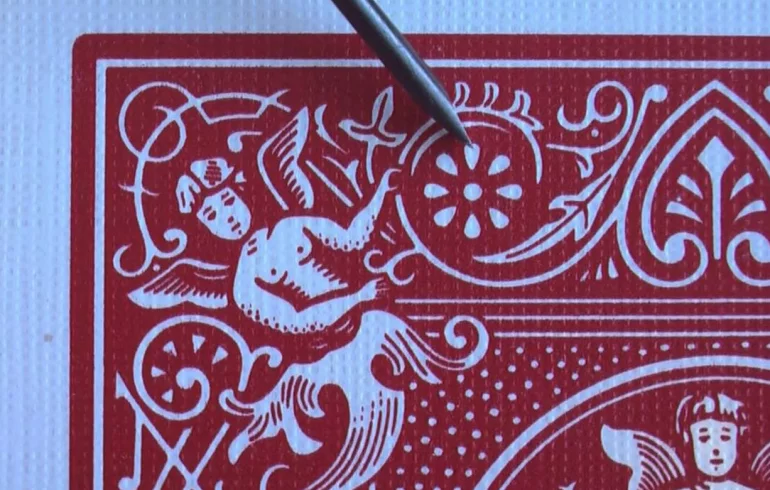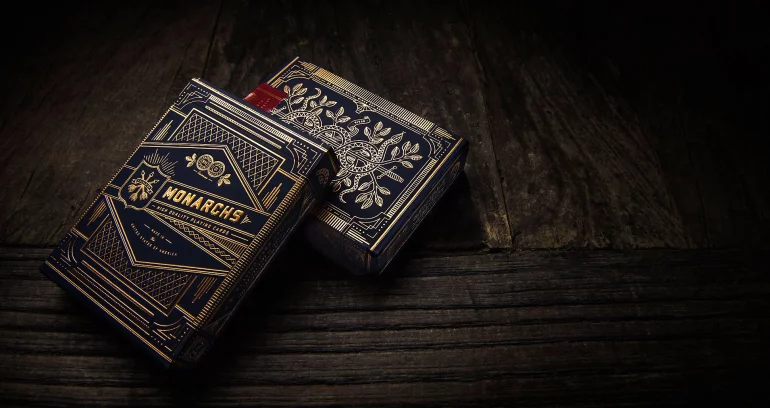
Card marking, a deceptive practice employed by dishonest gamblers, involves subtly altering cards to gain an unfair advantage. By discreetly marking cards with tiny symbols, ink stains, or other markings, cheaters can identify specific cards within a deck, enabling them to make informed bets and manipulate the outcome of games. This insidious practice poses a significant threat to the integrity of casino games and can result in substantial financial losses for casinos.
How Card Marking Works: A Closer Look
Card marking is a complex art that requires precision and subtlety. Cheaters employ various techniques to subtly alter cards, making them identifiable without arousing suspicion.
Ink and Dye Stains
- Invisible Ink: Employing specialized inks that become visible only under specific lighting conditions, such as ultraviolet light. These markings can be as simple as a dot or a more complex symbol, giving the cheater vital information about the card's value and suit.
- Micro-Dots: Tiny, almost invisible dots are applied to the card's surface using specialized pens or markers. These dots, often strategically placed within the card's design, can reveal the card's identity to a trained eye.
Edge Marking
- Edge Nicks: Minute nicks or chips are made on the edge of the card, usually with a sharp tool. Cheaters can easily detect these subtle alterations, especially when viewed from a specific angle or under certain lighting conditions.
- Edge Shading: A slight difference in color or texture is created on the edge of the card, often by applying a chemical substance or using a specialized technique. This subtle shading can be used to identify specific cards, especially when viewed from a particular angle.
Back Marking
- Symbol Marking: The back of the card is marked with tiny symbols, such as dots, lines, or letters. These symbols can be applied using ink, pencil, or a specialized marking device.
- Pattern Marking: Subtle alterations to the card's back pattern, such as a slightly different shade or texture, can be used to identify specific cards. This technique often requires a keen eye and practice to detect.
Chemical Treatments
- Chemical Stains: Chemicals are applied to the card to change its color or texture under specific lighting conditions. These chemicals can create subtle markings only visible under certain types of light, such as UV or infrared light.
Advanced Techniques
- Marked Decks: Specially prepared decks of cards with pre-marked symbols or patterns. Professional card cheats often use these decks and can be difficult to detect without specialized equipment.
- Electronic Devices: In recent years, technology has advanced to the point where cheaters can use electronic devices to identify cards. These devices can range from simple devices that use infrared light to more sophisticated devices that can analyze the card's pattern and identify it instantly.
By understanding these techniques, casino staff can be better equipped to identify and prevent card marking, ensuring the fairness and integrity of their games.
How the Best Cheats Mark Cards
Professional fraudsters use special solutions for tagging, which can resemble eye shadow, lipstick, or even dust.
The problem is that such substances are almost invisible to the naked eye.
They don't dull the coloring, fade over time, and are hard to spot, even when looking at the cards up close. Cheats manage to see the marks with the help of special glasses or contact lenses. As a rule, if red color prevails in the design of the card shirt, the marks are made with a solution that looks green through the lenses. To see them, the lenses must have special spraying, creating the effect of red eyes.
However, progress does not stand still, and now there are already lenses devoid of this disadvantage. So, it is almost impossible to recognize a cheat by the color of their eyes.
Glasses, even sunglasses, also do not cause strong suspicion, especially when playing Texas Hold'em and other varieties of sports poker. Here, casino customers play each other and often wear glasses so that the opponents can not read anything from their eyes.
Identifying Marked Cards
Recognizing marked cards requires a keen eye, patience, and, sometimes, specialized equipment. Here are some techniques used to detect these subtle alterations.
Visual Inspection
- Irregularities in the Card's Surface: Look for any unusual bumps, scratches, or discolorations on the card's surface.
- Unusual Patterns or Symbols: Pay close attention to the card's design and look for any added marks, dots, or lines.
- Edge Examination: Inspect the edges of the card for any nicks, chips, or unusual shading.
- Back Design Analysis: Carefully examine the back of the card for any alterations to the pattern or the addition of symbols.
Specialized Equipment
- Card Scanners: These devices can quickly scan a deck of cards and identify any irregularities, such as marked cards.
- UV and Infrared Light Sources: These tools can reveal markings that are invisible to the naked eye, such as those made with invisible ink or chemical treatments.
Training Casino Staff
- Regular Training Sessions: Conduct regular training sessions to educate staff on the latest card marking techniques and identification methods.
- Hands-On Practice: Provide staff with opportunities to practice identifying marked cards using various techniques.
- Encourage Vigilance: Emphasize the importance of vigilance and reporting suspicious behavior or unusual card patterns.
By combining visual inspection, specialized equipment, and rigorous training, casino staff can effectively identify and prevent card marking, safeguarding the integrity of their games.
Identifying Fraudsters Who Mark Cards
Professional card sharpers are sophisticated; catching them on the hot spot is extremely difficult. The solutions used are only visible through special lenses and do not appear in ultraviolet light. Lenses look natural, and millions now use this vision correction method.
A casino can minimize the risk of such cheating if it listens to the advice of professionals and at least tries to implement it. They recommend the following.
- First, carefully examine all the players in the casino lobby, especially those who look suspicious.
- Of course, you need to check their cards for any visible damage.
- If they are okay, but suspicions remain, try to discreetly find out whether the customer wears contact lenses and where he can keep the solution for marking cards.
Remember that the solution can be small. It's enough to put a thick layer on an object and slowly move your finger. There are cases when cheaters put the solution on the rims of glasses, buttons, cigarette packs, beer bottles, etc. One known cheater was caught when he always took casino chips in a thick material layer. Women often store solutions in powder, lipstick, and other cosmetics.
Tracing when a cheater puts his fingers into a solution is extremely difficult. If he is experienced and intelligent enough, it will look like a natural movement, unlikely to cause the slightest suspicion. For example, if a substance is on a mobile phone keypad or lighter, he will quietly take it, making calls or getting a light. But pay attention to the movement of his fingers. That's where he can give himself away.

And once again, check the eyes of the players and their looks. We have already decided that glasses or contact lenses are not a reason to suspect them for a client. However, his looks can tell a lot. Do not think that cheaters will stare at the cards while a hand looks at the mark. Professionals try to do it quickly and still do not observe the distribution process.
If they are ready to talk with you, try to ask them questions or start a conversation about the game. At the same time, look them straight in the eye, forcing them to do the same. Most gamblers try to cast at least a fleeting glance at the cards. If the visitor is highly interested in the process, this may be a reason to look at him more closely.
In any case, do not forget that many professionals do not work alone. A person you suspect of cheating may play only a diversionary role, and the main cheater remains in the shadows and quietly does the work.
They can sit at a busy table opposite each other. At the same time, a significant player can be without lenses or glasses. It all shows that the dealing of cards does not interest him. Therefore, he communicates with the other visitors and waiters, raises a drink from the table, and so on. The partner marks cards and gives him signals, but he plays poorly.
So keep an eye on all the players at the table. Entirely unexpected visitors may cause danger to the casino. But do it carefully and tactfully. In the end, you do not want to make an honest customer feel uncomfortable in the walls of your casino.
In some games, you can use distribution features to make life difficult for cheaters. For example, if a dealer in the Caribbean poker opens the first card, and the remaining four are under them, the cheater will hardly see the mark. Keeping the top card in the deck is also helpful before each hand or exchange. We should not allow the dealer to put the cards in a row.
The Most Dangerous Card Marking Technique
In our opinion, the greatest danger to the casino is marking cards before they are into play. It must involve employees or card providers.
- A bribed manager or pit boss substitutes a deck of cards.
- A casino buys marked cards.
To avoid it, streamline the process of using new decks.
- They may be under constant video surveillance.
- You may also have a security officer.
- In short, the more control - the less the likelihood of cheating.
- Purchase cards from reliable suppliers.
- It is best to order them directly from the manufacturer, if possible.
- Try to give access to cards to a minimum number of people before they enter the casino hall.
It is better to be extra cautious than to be cheated.
| Casino | Bonuses | Editors rating | |||
| 100% to 1000 € x35 | Play | ||||
| 100% to 100 $ x35 | Play | ||||
| 100% to 200 $ x35 | Play | ||||
| 200% to 49 € x25 | Play | ||||
| 200% to 49 $ x25 | Play |
Conclusion
There are many ways to mark cards. Indeed, not all of them are well known. Therefore, protecting a casino from it by a hundred percent is hardly possible. So be extremely cautious, carefully work with clients, and stop it if you have developed paranoia.
Card marking remains a persistent threat to the integrity of casino games. By understanding the techniques employed by cheaters, implementing effective security measures, and training staff to identify suspicious behavior, casinos can significantly reduce the risk of this deceptive practice.
Casino staff must stay informed about the latest card marking techniques and be vigilant in their observations. By working with law enforcement and utilizing advanced technology, casinos can create a secure environment that protects players and the casino's reputation.
Remember, the key to preventing card marking lies in vigilance, technology, and training.
By adopting a multi-layered approach, casinos can safeguard the integrity of their games and ensure a fair and enjoyable experience for all players.





















